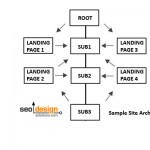Creating optimal URL structure is critical to search engine optimization. The one-off site structure is an SEO tactic that has been around for over 10 years and silently kicking dents in the SERPs ever since the inception of search engines.
What is the one-off? – The one-off is when you use a specific type of site architecture to (a) percolate regions of a website for later use by incubating trust by using a keyword rich or succinct sub folder and then (b) only have one file that gets fed by this subfolder as a consolidated beacon.
- domain.com/services
- domain.com/company
- domain.com/professionals
The sub folder in turn receives link flow from stemmed anchor text variations from a collaboration of on page and off page locations:
- keywords and modifiers with services links to /services
- keywords and modifiers with company links to /company
- keywords and modifiers with professional links to /professionals
As long as one of the keywords overlap to the target page semantically, that page (the one-off) can consolidate rankings for the anchor-text key phrase variation and / or pass along ranking factor for stemmed related keywords.
This tactic also leaves a smaller footprint than blatantly obvious inbound or internal linking methodologies. Something as simple as (keyword rich title tag suffix add ons, server side includes or alt attributes with images) linking to preferred pages can tip the scale of relevance in your favor.
Managing the Exchange
There are 2 things to consider for producing rankings (a) how much internal link flow a page receives from the other pages in the website (b) how much inbound internal link flow it receives from other websites and (c) the trust and relevance of both the on page content and the off page inbound links continuity.
SEO Friendly Structures for SEO Types
Flat site architecture – Flat site architecture uses keyword rich anchor text with the bulk of files / pages in the root folder to feed each other through primary or secondary navigation.
This is extremely effective when link flow is directed at the root folder and each page is linked properly to ensure that “no page is left behind”.
Using “exact match” naming conventions in tandem with an enticing meta description (including 2 alternate keywords such as a plural and / or modifier and synonym) to act as a catch all for related phrases is also commonly used to augment flat site architecture.
Add lateral internal linking to this formula and you have a powerhouse e-commerce site in process which over time will be replete with PageRank, page authority and rankings.
The PageRank ensures the page remains indexed and buoyant, while the on page signals from the page continually stem and the page can rank like a catch all with additional keyword variations all funneling to the most technically relevant landing page.
Theming and Siloing – Theming and siloing involves targeting a broad level phrase and using that keyword as the beacon top tier or tier one of the hierarchy.
The subsequent pages under that theme (which are keywords threaded with the main semantic keyword) referred to as “theme density” are then used in tandem on child pages under the parent / primary site architecture.
This creates a type of concatenation that uses the primary root phrase and reinforces topical relevance for a chain of keywords in the silo. There are advantages and disadvantages to this strategy.
The advantage is if you theme/point the links from the collective pages in the proper place, no keyword is too large to overcome over time through adding content, internal links and deep links in tandem.
The disadvantage is, if you do it wrong, then the pages do not reach sufficient page authority and your silos fall short of the target with no clear champion page in site.
This is why it is important to designate subordinate pages for each keyword within a site, then, determine how you want to feed those pages in the site architecture.
You can feed silos from the top down or the bottom up. Top down implies you use the tier one tip of the subfolder and link to it to force page PageRank or link flow deeper into the pages. You can feed mid-tail, long-tail or geo specific pages from this type of linking structure.
Bottom up, implies you use deep links from other (preferably themed sources) that reflect the same type of content or theme (linking a like to a like) using deep linking and linking directly to those sub / child pages within the silo.
Then, with the limited links leaving those pages, they consolidate link flow for specific / themed keywords and can act as intermediaries to rank your preferred landing pages without those pages themselves trying to horde rankings or occupy the SERPs.
Tactical SEO Takeaways and Tips
The one off is like a combination of the two tactics; it uses the tier one beacon from the site architecture using a relevant themed keyword, but often becomes the stand alone page which receives its link flow from other lateral areas within the website vs. receiving buoyant links from a silo of pages underneath.
The way to activate this type of page is to use a wild card internal linking method which does not focus on one specific of unique keyword variation for the landing page, but rather stemmed variations of the keywords all linking to the one-off subfolder with any keyword combination a ranking is desired for.
Let’s just say the subfolder is services and the domain already has relevance for a keyword. Now when you link to the subfolder you can link with the anchor text “keyword services”, “professional keyword services”, “affordable keyword services”, etc. Obviously replace “keyword” with your actual term.
By varying the main anchor with a combination of modifiers, that page can take on the persona of the internal or deep links characteristics to that page. Also, that page can now act as a semantic hub to “pass along” link flow and ranking factor to other pages based on that keywords semantic theme through link osmosis.
It is through this layering process that you selectively execute this type of site structure to target multiple keyword variations simultaneously.
We only used tier one in this instance, however, you can feed up to three tiers or subfolders deep using this daisy-chain like linking effect where each tier uses (a) capped contextual links per page or (b) a secondary drill-down navigation structure to funnel link flow deeper into the site.
The way you mine and extract that link flow is to point it at flat pages in the site architecture that receive their primary push from the internal links (from deeper silos).
In essence, the keyword rich subfolder acts and functions like a second homepage or sub site within your website and consolidate a topical node of relevance for a semantic piece of the puzzle for your keyword / ranking strategy.
The effectiveness of this tactic is unparalleled for effectiveness. We have used this method successfully on numerous occasions to lock down competitive keyword variations by using the internal link dynamo in tandem with a few hundred deep links to lock down #1 positions once you cross the tipping point .
The one off directory structure is a great tactic for targeting multiple competitive keywords and not having to rely on flat site architecture and also allows you to theme and silo if necessary (by building sub pages under the subfolders).
It is merely one of dozens of potential methods for sculpting link equity within a website and controlling which anchors flow into and leave themed pages to “pass along” vital ranking factor where needed or at will.












Great post again!
I like that last part “Tactical SEO Takeaways and Tips”.
I have a couple of ?’s ;)
If you have say 3 Silo, with each Silo having 3 sub-pages. Would the last sub-page of the 3rd Silo, link forward to any other page on the site?
Everything I’ve found so far suggest to leave that last page hanging, with no forward Anchor-Text link.
Is that correct, or would it be better to close the loop?
Thanks,
Hey SlimJim:
Glad you liked the post.
Regarding the third tier…I would close the loop on that one by using homepage or ensure it has enough links from other sites to pass more link flow.
I meant lateral subfolders such as domain.com/sub1/sub2/sub3 when I mentioned this tactic.
Anything more is better served as a sub domain with deep links vs. keeping them in formation.
Jeffrey,
Thanks, for the reply.
I’m in the planning stage for a small site, & wanted to try a Silo structure.
So maybe every page won’t need to depend on external high PageRank backlinks… ;)
Sure Thing SlimJim:
Just make sure the content post frequency is high to expedite trust. After about 3-4 months, you should be in a great space with one post per day (time released) and using RSS syndication and internal links.
Make sure when you want to get the equity out of the silos that you link to a flat page in exact match to act as the champion page for the SERPs.
All the best…
Well Written Article ON SEO URL Structure. Very Very Useful Tips to All Web Masters.
It is really a nice & informative post regarding proper SEO URL structure. All the tips you have shared are worth keeping in mind while following the same process. Anyways thanks a lot for sharing your beautiful information.
There’s a usability aspect to creating that subfolder as well. If your URL is “domain.com/events,” or “domain.com/staff,” etc. people will be able to infer from the URL that you have more of the content type they’re currently viewing. They may well be encouraged to look for more events or staff members on your site. Good URL structure makes sense for SEO, and it makes sense for people, too.